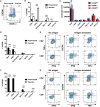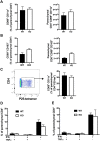CXCR6-Deficiency Improves the Control of Pulmonary Mycobacterium tuberculosis and Influenza Infection Independent of T-Lymphocyte Recruitment to the Lungs
- PMID: 30899256
- PMCID: PMC6416161
- DOI: 10.3389/fimmu.2019.00339
CXCR6-Deficiency Improves the Control of Pulmonary Mycobacterium tuberculosis and Influenza Infection Independent of T-Lymphocyte Recruitment to the Lungs
Abstract
T-lymphocytes are critical for protection against respiratory infections, such as Mycobacterium tuberculosis and influenza virus, with chemokine receptors playing an important role in directing these cells to the lungs. CXCR6 is expressed by activated T-lymphocytes and its ligand, CXCL16, is constitutively expressed by the bronchial epithelia, suggesting a role in T-lymphocyte recruitment and retention. However, it is unknown whether CXCR6 is required in responses to pulmonary infection, particularly on CD4+ T-lymphocytes. Analysis of CXCR6-reporter mice revealed that in naïve mice, lung leukocyte expression of CXCR6 was largely restricted to a small population of T-lymphocytes, but this population was highly upregulated after either infection. Nevertheless, pulmonary infection of CXCR6-deficient mice with M. tuberculosis or recombinant influenza A virus expressing P25 peptide (rIAV-P25), an I-Ab-restricted epitope from the immunodominant mycobacterial antigen, Ag85B, demonstrated that the receptor was redundant for recruitment of T-lymphocytes to the lungs. Interestingly, CXCR6-deficiency resulted in reduced bacterial burden in the lungs 6 weeks after M. tuberculosis infection, and reduced weight loss after rIAV-P25 infection compared to wild type controls. This was paradoxically associated with a decrease in Th1-cytokine responses in the lung parenchyma. Adoptive transfer of P25-specific CXCR6-deficient T-lymphocytes into WT mice revealed that this functional change in Th1-cytokine production was not due to a T-lymphocyte intrinsic mechanism. Moreover, there was no reduction in the number or function of CD4+ and CD8+ tissue resident memory cells in the lungs of CXCR6-deficient mice. Although CXCR6 was not required for T-lymphocyte recruitment or retention in the lungs, CXCR6 influenced the kinetics of the inflammatory response so that deficiency led to increased host control of M. tuberculosis and influenza virus.
Keywords: CXCR6; influenza; lung; tissue-resident memory; tuberculosis.
Figures








Similar articles
-
CXCR6 is a marker for protective antigen-specific cells in the lungs after intranasal immunization against Mycobacterium tuberculosis.Infect Immun. 2011 Aug;79(8):3328-37. doi: 10.1128/IAI.01133-10. Epub 2011 May 31. Infect Immun. 2011. PMID: 21628524 Free PMC article.
-
Sequential pulmonary immunization with heterologous recombinant influenza A virus tuberculosis vaccines protects against murine M. tuberculosis infection.Vaccine. 2018 Apr 25;36(18):2462-2470. doi: 10.1016/j.vaccine.2018.03.037. Epub 2018 Mar 27. Vaccine. 2018. PMID: 29602704
-
Suppressed induction of mycobacterial antigen-specific Th1-type CD4+ T cells in the lung after pulmonary mycobacterial infection.Int Immunol. 2010 Apr;22(4):307-18. doi: 10.1093/intimm/dxq010. Epub 2010 Feb 18. Int Immunol. 2010. PMID: 20167585
-
CXCR6 expressing T cells: Functions and role in the control of tumors.Front Immunol. 2022 Oct 12;13:1022136. doi: 10.3389/fimmu.2022.1022136. eCollection 2022. Front Immunol. 2022. PMID: 36311728 Free PMC article. Review.
-
Control of innate immunity by memory CD4 T cells.Adv Exp Med Biol. 2011;780:57-68. doi: 10.1007/978-1-4419-5632-3_6. Adv Exp Med Biol. 2011. PMID: 21842365 Free PMC article. Review.
Cited by
-
Dynamics of pulmonary mucosal cytotoxic CD8 T-cells in people living with HIV under suppressive antiretroviral therapy.Respir Res. 2024 Jun 12;25(1):240. doi: 10.1186/s12931-024-02859-2. Respir Res. 2024. PMID: 38867225 Free PMC article.
-
Antigens of Mycobacterium tuberculosis Stimulate CXCR6+ Natural Killer Cells.Front Immunol. 2020 Sep 28;11:582414. doi: 10.3389/fimmu.2020.582414. eCollection 2020. Front Immunol. 2020. PMID: 33117393 Free PMC article.
-
Elevated plasma levels of CXCL16 in severe COVID-19 patients.Cytokine. 2022 Apr;152:155810. doi: 10.1016/j.cyto.2022.155810. Epub 2022 Jan 31. Cytokine. 2022. PMID: 35121493 Free PMC article. Clinical Trial.
-
A vaccine combination of lipid nanoparticles and a cholera toxin adjuvant derivative greatly improves lung protection against influenza virus infection.Mucosal Immunol. 2021 Mar;14(2):523-536. doi: 10.1038/s41385-020-0334-2. Epub 2020 Aug 17. Mucosal Immunol. 2021. PMID: 32807838
-
CD4, but not Cxcr6, is necessary for control of Pneumocystis murina infection.Microbes Infect. 2025 Feb;27(2):105408. doi: 10.1016/j.micinf.2024.105408. Epub 2024 Aug 23. Microbes Infect. 2025. PMID: 39182643
References
Publication types
MeSH terms
Substances
LinkOut - more resources
Full Text Sources
Molecular Biology Databases
Research Materials

